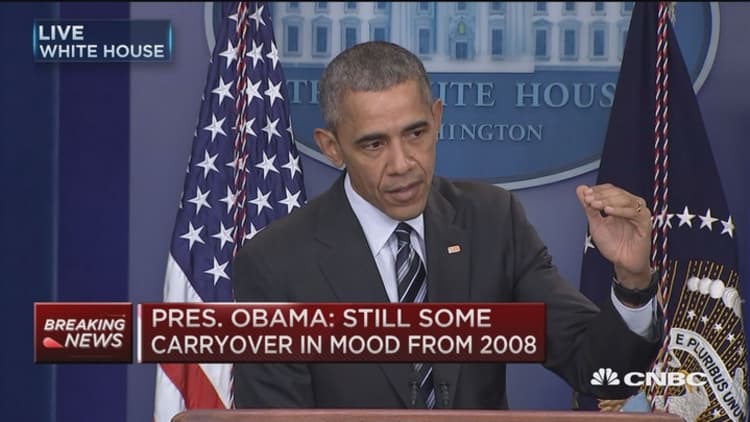
For more than seven years, Federal Reserve officials have touted their progress toward achieving "full employment," with the most recent target a 4.9 percent unemployment rate.
With Friday's nonfarm payrolls report showing that the goal has been achieved, perhaps the Fed can raise the "Mission Accomplished" banner along with a welcome mat to the world of "full employment."
The jobless rate last reached this level in February 2008, following a run from June 2005 to April 2008 during which unemployment never eclipsed 5 percent. Getting a "4-handle" on the number — using Wall Street lingo — was supposed to represent jobs nirvana, the point at which the Fed finally would be able to declare victory and meaningfully begin to roll back its excessive easing programs that began in 2008.
But with the 5 percent goal line crossed, the jobs market remains a riddle. Consistent job creation has come with less robust gains in wages, and a seemingly positive report in most aspects was greeted with a strong sell-off on Wall Street.
In short, it was supposed to feel better than this.
Read More Jobs report eliminates some pessimism over economy
Government numbers "don't show the quality of the jobs. They don't obviously pick up the anxiety that workers are feeling," said Joseph LaVorgna, chief U.S. economist at Deutsche Bank. Concerns over job security, particularly about being displaced by technology disruptors, "may also be adding to economic jitters and uncertainties," he added. LaVorgna said he believes the economy actually is near full employment, though it doesn't seem that way to many in and out of the labor force.
Indeed, January's numbers highlighted a long-standing trend: Despite a bump in average hourly wages, many of the jobs are still weighted toward the lower end of the pay scale, and that comes nearly seven years into a recovery. Bars and restaurants, for instance, have added 384,000 of 2.6 million jobs created over the past year.
Still, President Barack Obama was there Friday praising the numbers, even though the total of 151,000 new positions was well below the 190,000 that wall Street economists had anticipated.
"The United States of America right now has the strongest, most durable economy in the world," he said at a news conference. "I know that's still inconvenient for Republican stump speeches as their doom and gloom tour plays in New Hampshire. I guess you cannot please everybody."
Read More Negative rates in US? Here's why it could happen
The president may have bragged about the unemployment rate's decline below 5 percent, but he knows the number doesn't tell the full story. The decline in the jobless rate has accelerated due to a generational low in labor force participation. Though the one-tenth point drop in January came with a slight rise in the LFP rate, a more encompassing measure that includes those who have left the workforce as well as the underemployed remained unchanged at 9.9 percent.
Even Obama, for all his partisan flame throwing, conceded "that we have more work to do," though he mainly focused on "softness in the global economy" that was making it rough on U.S.-based multinational companies.
Investors are familiar with the work that has to be done.
The fourth-quarter earnings cycle is more than 60 percent complete, and the is tracking for an aggregate annualized profit decline of 5.1 percent, according to S&P Capital IQ. That comes as dropping productivity is pushing unit labor costs higher, which in turn will pressure profit margins, the expansion of which has fueled the nearly seven-year bull market run on Wall Street.
Read More Citi: World economy seems trapped in 'death spiral'
Companies facing earnings pressure don't hire workers, and they don't invest in capital expenditures, which declined 1.8 percent in the fourth quarter.
"The problem with the optimist narrative is that so much of total private sector gains are in low-wage industries — hardly the broadening of employment the Fed is looking for," Steve Blitz, chief economist at ITG Investment Research, said in a note to clients. "Most industry sectors still employ fewer people than they did when the recession began."
Consumers, meanwhile, are enjoying their savings at the gas pump but not so much that they're running out and spending freely or running up credit; the personal savings rate is at 5.5 percent, while household debt increased just 1.5 percent in the most recent reporting period.
Faced with conflicting signs about the future of the jobs market, and the dilemma of whether the 2.5 percent average earnings gain would push the Fed to hike rates again sooner than expected, traders on Friday headed for safety. Major stock averages declined 1 percent or more while government bond yields, which were supposed to rise along with the Fed's target rate, again fell to the point where the benchmark 10-year yield hovered near its lowest level in about a year.
Not exactly signs of a bustling economy that can be declaring a victory of any sort yet.






